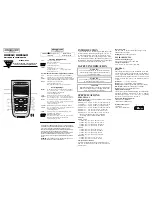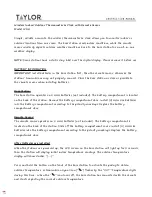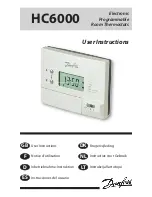
•
Use multi-stage heating and cooling equipment so the equip-
ment capacity can match the load when only a limited number
of zones require conditioning.
•
Select an air handler that is designed to overcome the high
static pressure in the ductwork and force more air through the
system. ECM is a good choice.
When selecting the appropriate approach for a retrofitted system,
be sure to inform the owner of the trade-offs between cost and
comfort when comparing approaches.
Return-air Ductwork
The return-air system should be able to remove the same amount
of air from each zone as was supplied to it. If each zone does not
have its own return, then a cross-contamination of zone tempera-
tures could occur. A good sizing method would be to size the
return at least as large as the main trunk of that particular zone.
Making Preliminary Zone Assignments
The owner’s/customer’s goals regarding comfort and energy
savings affect how many zones are appropriate for the system:
•
In a system designed primarily for comfort, all zones usually
have comfort set points that remain relatively constant and that
have similar time schedules. Such a system may have a large
number of zones (5 to 8) of a relatively small size.
•
In a system designed primarily for energy savings, zones must
be larger to guarantee proper airflow to the zones that need
conditioning (occupied), while the remaining zones will be
closed (unoccupied). Such a system generally must have a
smaller number of zones of a relatively larger size. In this case,
you must be careful not to “over zone” (i.e., assign too many
zones).
When making zone assignments, use the information that you
gathered when conducting the site survey. Group areas that:
•
Are in use around the same time of day. For example, it often
makes sense to assign all bedrooms to a single zone because
they are occupied only during the night time when other rooms
in the home are not occupied.
•
Have similar heating and cooling needs.
•
Are physically separated from other areas.
•
Are on the same level of the home. For example, the rooms on
the upstairs level often have a different heating and cooling
demand when compared to rooms downstairs. The differences
can be due to the tendency for heat to rise, different use or
occupancy, and the roof heat load.
•
Have similar exposures to external heating gains and losses.
For example, it often makes sense to assign rooms with large
amounts of glass and western or southern exposure to the same
zone.
If possible, discuss these considerations with the owner. Get the
owner’s input before making initial zone assignments. Mark your
preliminary zone assignments on the Floor Plan Worksheet pro-
vided in the Appendix. At this point, consider your zone assign-
ments to be preliminary.
II.
SIZING THE EQUIPMENT
A.
Task 3–Calculate block load estimates and zone
load estimates
Using the information that you gathered in Task 2, calculate both
heating and cooling load estimates (block load) for the entire
home/building.
The standard Btu load calculations used for non-zoned systems
apply equally well to zoned systems. Use a reliable method with
which you are comfortable. This information will be submitted in
Step 1 of the Duct Sizing Worksheet.
Next calculate individual “room-by-room” heating and cooling
load estimates (in Btu’s) for the home/building. This information
will be submitted in Step 2 of the Duct Sizing Worksheet. Then,
tentatively choose zone loads by adding rooms together and
writing them into Step 3 of the Duct Sizing Worksheet.
The zone load estimates are used to determine whether the zone
assignments you have make sense. They are also used to size the
zone dampers and ductwork.
B.
Task 4–Size heating and cooling equipment
Zone Perfect Plus is designed for use with residential furnaces, fan
coils and light commercial products. Whenever possible, a ther-
mostatic expansion valve (TXV) should be used. Zone Perfect Plus
is designed to operate with equipment in a range of 1.5 to 12.5 tons
in cooling mode.
How to determine the appropriate size of heating and cooling
equipment is a challenge that is subject to many debates. In a
zoning system, there is a very good possibility that a system will
use all zones on a given day. For that reason, we recommend that
you select the size of heating and air conditioning units based on
either the home’s/building’s block heating load or block cooling
load. Select the size of the air handling unit based on the load with
the largest required CFM (heating or cooling CFM, whichever is
larger). However, because the zoning system has the capability to
not condition some zones at any given time, and because it is
essential to maintain minimum airflow through the system at all
times, it is better to use slightly undersized equipment than slightly
oversized equipment in a zoning system.
Select heating and cooling equipment to meet the block heating
and cooling block load estimates that you have written into Step 1
of the Duct Sizing Worksheet. Use the Product Data for the
equipment that you are considering, determining whether the
equipment can meet the system’s needs. Verify that the selected
indoor air handler can meet the heating and cooling airflow
requirements. Write this information into Step 4 of the Duct Sizing
Worksheet.
In a zoning system, it is especially important to select heating and
cooling equipment that is not too large. Equipment that is larger
than necessary compounds the problem of keeping the airflow in
the system above the minimum required by the equipment when
few zones require conditioning. Because the zoning system shuts
down the equipment if the duct temperature falls outside the
minimum or maximum temperature limits, and limits the number
of times the equipment can restart to four times per hour, the actual
capacity provided by the system can be smaller with larger
equipment.
To help avoid such problems, size the equipment based on the
calculated block heating and cooling airflow (whichever is larger)
of the space. Do not add a fudge factor. Under even the heaviest
loads, the system has the capability to send its entire capacity to
less than the entire space. To redirect capacity where it is most
needed, the owner can easily set back some zones.
Protecting equipment with a Zoning System
Any time zoning is applied to heating and cooling equipment,
additional requirements must be performed. Variable-speed or
multi-speed residential equipment must have the logic removed,
which allows the zoning system to be in charge of staging.
Any cooling equipment that is going to run below its standard
minimum outdoor temperature must have low ambient kits and
wind baffles installed. Freeze-stats are required to protect the
equipment in the case the Leaving Air Temperature (LAT) sensor
cannot react quickly enough or has been disabled. For residential
equipment, consult the Application and Service manuals for the
required accessories. For Light Commercial (Tyler) products, see
the Product Data for the descriptions of the freeze-stats, wind
baffles, and MotorMaster options. When matched with zoning,
varying speed condensor motors are recommended over the less
expensive fan cycling controls.
III.
SIZING THE DUCT SYSTEM
A.
Task 5–Determine bypass needs
A way of bypassing air in the worst-case scenario (only one room
zone open while the other zones are closed) needs to be consid-
ered. Traditionally, a Barometric Bypass has been the only option.
—3—
Содержание ZONE PERFECT PLUS
Страница 8: ...A98347 Floor Plan Worksheet 8 ...
Страница 23: ... 23 ...




































